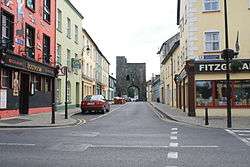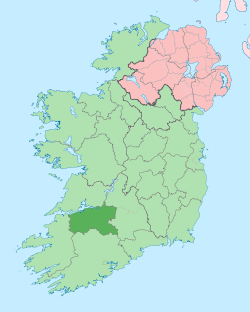Kilmallock
| Kilmallock Cill Mocheallóg | |
|---|---|
| Town | |
|
Blossom Gate on Emmet Street, Kilmallock | |
 Kilmallock Location in Ireland | |
| Coordinates: 52°23′56″N 8°34′30″W / 52.399°N 8.575°WCoordinates: 52°23′56″N 8°34′30″W / 52.399°N 8.575°W | |
| Country | Ireland |
| Province | Munster |
| County | County Limerick |
| Population (2006)[1] | |
| • Urban | 1,443 |
| • Rural | 1,977 |
| Irish Grid Reference | R607277 |
Kilmallock or Kilmalloc (Irish: Cill Mocheallóg) is a town in south County Limerick, Ireland, near the border with County Cork. There is a Dominican Priory in the town and King's Castle (or King John's Castle). The remains of medieval walls which encircled the settlement are still visible. The Dublin–Cork railway line passes by the town, but the station is now closed. The nearest train station is in Charleville, a few miles south west of Kilmallock.
History

Saint Mocheallóg built a church in the area in 6th or 7th century, and the town's name derives from the Irish Cill Mocheallóg meaning "the church of Mocheallóg".
The town was of considerable importance in the late medieval period, ranking as one of the main urban areas in Ireland at the time. Kilmallock was located in a position of some strategic importance, and in consequence the town frequently became a target during times of war. In 1571, the town was burned by the rebel Earl of Desmond during the Desmond Rebellions. Seventy years later, during the Irish Confederate Wars, the Dominican Priory of Kilmallock was attacked and destroyed by a Parliamentary Army under Lord Inchiquin in 1648. Its ruins are the best known historic landmark of Kilmallock. The local cemetery is the burial place of the noted eighteenth-century poet Andrias Mac Craith. Better known as An Mangaire Súgach, his best known poem is "Slán le Máigh", a song in praise of the entire Maigue valley when he was temporarily exiled from it. The house where he died still stands at the bottom of Wolfe Tone Street near the River Loobagh. The house known as Tigh An Fhile has information panels about the poet at the doorway. The town also has a small museum depicting the historic past of this once great Geraldine fortress town. It is located on the way to the Dominican Priory.
During the battle of Killmallock the town saw bitter fighting in July 1922 during the Irish Civil War, when it was held by anti-Treaty forces under Liam Deasy and eventually taken by Free State troops under Eoin O'Duffy, which was an event which among others contributed to the dissolution of the short-lived Munster Republic.
As part of a brief but vicious sectarian campaign in July 1935, arsonists burnt the Church of Ireland building to the ground, causing damage costing thousands of pounds.[2]
Sports
Members of the local Kilmallock GAA club have represented Limerick in the Munster hurling and All-Ireland hurling championships. The club have won 11 senior county hurling titles, most recently in 2014. The club also won the Limerick Minor Hurling Championship last in 2010.
The area is home to the Kilmallock Cycling Club, Kilmallock Athletic Club and also a centre for horse breeding - with several stallion farms located in the district.
Economy
Kilmallock is twinned for socio-economic purposes with Croom in County Limerick, and has a wide range of services and businesses operating in the town.
Annalistic references
From The Annals of the Four Masters:
- M1571.4. James Mac Maurice took Kilmallock, not from a desire of obtaining its riches and various treasures, though its riches were immense, but because it had always been the rendezvous and sally-port of the English and Geraldines in their contests against him. Before sunrise in the morning those who had gone to sleep happily and comfortably were aroused from their slumber by a furious attack made by the warlike troops of the Clann-Sweeny and Clann-Sheehy, who were along with James Mac Maurice; and they proceeded to divide among themselves its gold, silver, various riches, and valuable jewels, which the father would not have acknowledged to his heir, or the mother to her daughter, on the day before. They were engaged for the space of three days and nights in carrying away the several kinds of riches and precious goods, as cups and ornamented goblets, upon their horses and steeds, to the woods and forests of Etharlach, and sending others of them privately to their friends and companions. They then set fire to the town, and raised a dense, heavy cloud, and a black, thick, and gloomy shroud of smoke about it, after they had torn down and demolished its houses of stone and wood; so that Kilmallock became the receptacle and abode of wolves, in addition to all the other misfortunes up to that time.
Literature
- Arlene Hogan: Kilmallock Dominican Priory: An Architectural Perspective, 1291-1991. Kilmallock Historical Society 1991.
- Mainchín Seoighe: The story of Kilmallock. Kilmallock Historical Society 1987.
- The Kilmallock Journal, published by the Kilmallock Historical Society
- Chun Gloire De, a guide to the very fine neo-Gothic Catholic Church
References
- ↑ http://beyond2020.cso.ie/Census/TableViewer/tableView.aspx?ReportId=75471
- ↑ Article by Tim Fanning, page 20, Sunday Independent, 22 February 2009
| Wikimedia Commons has media related to Kilmallock. |

